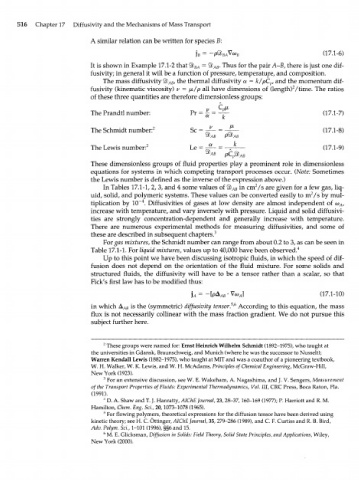Page 536 - Bird R.B. Transport phenomena
P. 536
516 Chapter 17 Diffusivity and the Mechanisms of Mass Transport
A similar relation can be written for species B:
j B = - ® Va> B (17.1-6)
B A
P
It is shown in Example 17.1-2 that % BA = ЯЬ . Thus for the pair A-B, there is just one dif-
АВ
fusivity; in general it will be a function of pressure, temperature, and composition.
The mass diffusivity 4t , the thermal diffusivity a — k/pC , and the momentum dif-
AB
p
2
fusivity (kinematic viscosity) v — /л/р all have dimensions of (length) /time. The ratios
of these three quantities are therefore dimensionless groups:
The Prandtl number: Pr = £ = -—- (17.1-7)
2
The Schmidt number: Sc = ^ - = -£- (17.1-8)
The Lewis number: 2 Le = -£- = — - — (17.1-9)
Э л в PC ®
P
These dimensionless groups of fluid properties play AB a prominent role in dimensionless
equations for systems in which competing transport processes occur. (Note: Sometimes
the Lewis number is defined as the inverse of the expression above.)
2
In Tables 17.1-1, 2, 3, and 4 some values of ЯЬ in cm /s are given for a few gas, liq-
АВ
2
uid, solid, and polymeric systems. These values can be converted easily to m /s by mul-
tiplication by 10~ . Diffusivities of gases at low density are almost independent of co ,
4
A
increase with temperature, and vary inversely with pressure. Liquid and solid diffusivi-
ties are strongly concentration-dependent and generally increase with temperature.
There are numerous experimental methods for measuring diffusivities, and some of
these are described in subsequent chapters. 3
For gas mixtures, the Schmidt number can range from about 0.2 to 3, as can be seen in
Table 17.1-1. For liquid mixtures, values up to 40,000 have been observed. 4
Up to this point we have been discussing isotropic fluids, in which the speed of dif-
fusion does not depend on the orientation of the fluid mixture. For some solids and
structured fluids, the diffusivity will have to be a tensor rather than a scalar, so that
Fick's first law has to be modified thus:
] A = -[p& Vco ] (17.1-10)
A
A[r
in which A AB is the (symmetric) diffusivity tensor. ' According to this equation, the mass
5 6
flux is not necessarily collinear with the mass fraction gradient. We do not pursue this
subject further here.
2
These groups were named for: Ernst Heinrich Wilhelm Schmidt (1892-1975), who taught at
the universities in Gdansk, Braunschweig, and Munich (where he was the successor to Nusselt);
Warren Kendall Lewis (1882-1975), who taught at MIT and was a coauthor of a pioneering textbook,
W. H. Walker, W. K. Lewis, and W. H. McAdams, Principles of Chemical Engineering, McGraw-Hill,
New York (1923).
3 For an extensive discussion, see W. E. Wakeham, A. Nagashima, and J. V. Sengers, Measurement
of the Transport Properties of Fluids: Experimental Thermodynamics, Vol. HI, CRC Press, Boca Raton, Fla.
(1991).
4 D. A. Shaw and T. J. Hanratty, AIChE Journal, 23, 28-37,160-169 (1977); P. Harriott and R. M.
Hamilton, Chem. Eng. Sci., 20,1073-1078 (1965).
5
For flowing polymers, theoretical expressions for the diffusion tensor have been derived using
kinetic theory; see H. C. Ottinger, AIChE Journal, 35, 279-286 (1989), and C. F. Curtiss and R. B. Bird,
Adv. Polym. Sci., 1-101 (1996), §§6 and 15.
6 M. E. Glicksman, Diffusion in Solids: Field Theory, Solid State Principles, and Applications, Wiley,
New York (2000).

